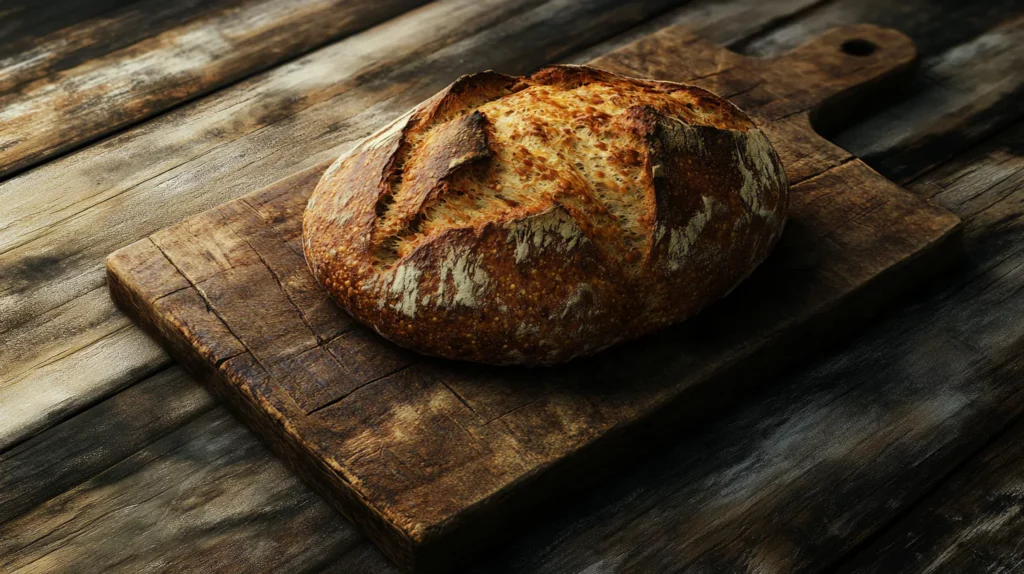Lentil bread has emerged as a popular alternative to traditional wheat bread, especially for those seeking healthier, protein-rich, and gluten-free options. But one common concern among health-conscious individuals is its carbohydrate content. Since lentils are legumes, they naturally contain carbohydrates, which raises the question: Is lentil bread high in carbs?
In this article, we’ll explore the nutritional profile of lentil bread, including its carb content, health benefits, and whether it’s suitable for low-carb or keto diets. We’ll also provide tips for making homemade lentil bread and answer common questions regarding its overall health impact. For a detailed step-by-step guide, check out this Lentil Bread Recipe.
Understanding Lentil Bread

What is Lentil Bread?
Lentil bread is a type of bread made primarily from lentils, which are legumes known for their high protein and fiber content. Unlike traditional wheat bread, lentil bread does not rely on flour from grains. Instead, lentils are ground or pureed to create a dough-like base. Lentil bread is often gluten-free, making it a favorite among those with gluten sensitivities or celiac disease.
There are various forms of lentil bread, including recipes made with red lentils, green lentils, or black lentils. Lentils are soaked, blended, and then baked into a nutrient-dense bread that can serve as a versatile base for sandwiches, toasts, or snacks.
How Lentil Bread Differs from Traditional Bread
Lentil bread differs from traditional wheat bread in a few key areas:
- Ingredients: While wheat bread uses refined or whole wheat flour, lentil bread uses lentils as its primary ingredient. This eliminates gluten and reduces some of the processed carbs typically found in white bread.
- Nutritional Profile: Lentil bread tends to be higher in protein and fiber compared to traditional bread. This makes it more satiating, helping you stay full for longer.
- Carbohydrate Content: Lentil bread still contains carbs, but these are complex carbohydrates, which digest more slowly and help stabilize blood sugar levels. In contrast, traditional bread often contains refined carbs that can spike blood sugar quickly.
- Gluten-Free Option: For those avoiding gluten, lentil bread is a natural choice since lentils are inherently gluten-free.
Nutritional Profile of Lentils
Understanding the nutritional profile of lentils is key to understanding lentil bread. Here is a breakdown per 100 grams of cooked lentils:
- Calories: 116 kcal
- Carbohydrates: 20 grams
- Protein: 9 grams
- Fiber: 8 grams
- Fat: 0.4 grams
Lentils are an excellent source of plant-based protein, which makes lentil bread a great option for vegetarians and vegans. They are also rich in dietary fiber, which aids digestion, promotes gut health, and slows down the absorption of sugar into the bloodstream. Additionally, lentils provide essential vitamins and minerals such as iron, folate, potassium, and magnesium.
These nutrients contribute to overall health, making lentil bread more nutrient-dense than many traditional breads. However, because lentils contain 20 grams of carbohydrates per 100 grams when cooked, the question remains: does this translate to high-carb bread? Let’s explore this further in the next section.
Here is the third part of the article:
Carbohydrate Content in Lentil Bread
Carbohydrate Composition of Lentils
To understand the carbohydrate content in lentil bread, it’s essential to break down the carb composition of lentils themselves. Lentils contain primarily complex carbohydrates, which differ from simple carbs found in refined sugars and white bread. Complex carbs take longer to digest, leading to a gradual release of energy and a lower impact on blood sugar levels.
Here’s a quick look at the carbohydrate breakdown of lentils:
- Total Carbohydrates (per 100 grams cooked): ~20 grams
- Dietary Fiber: ~8 grams
- Net Carbs (Total Carbs – Fiber): ~12 grams
The concept of “net carbs” is especially important for individuals following low-carb diets. Since fiber doesn’t cause blood sugar spikes and isn’t digested in the same way, it’s often subtracted from the total carb count. In lentils, the high fiber content reduces the effective net carbs, making them a healthier carb choice.
Carb Count in Lentil Bread vs. Wheat Bread
When it comes to lentil bread, the carb count varies based on the recipe. Here is a general comparison between lentil bread and traditional wheat bread:
| Bread Type | Carbohydrates (per slice) | Fiber | Net Carbs |
|---|---|---|---|
| Lentil Bread | 15-20 grams | 3-6 grams | 10-14 grams |
| White Bread | 25-30 grams | 1-2 grams | 23-29 grams |
| Whole Wheat Bread | 20-25 grams | 2-4 grams | 18-21 grams |
From this table, it’s clear that lentil bread generally has fewer net carbs compared to white or whole wheat bread. The high fiber content in lentil bread helps offset the total carbs, making it a more balanced option for those watching their carbohydrate intake.
Factors Influencing Carb Levels
The carb content of lentil bread can vary based on a few factors:
- Recipe Ingredients: Some recipes add additional flour, sweeteners, or grains, which can increase the total carb count. Pure lentil bread, made solely from lentils and water, will have fewer carbs.
- Serving Size: A larger slice of lentil bread will naturally contain more carbs. Practicing portion control is key if you’re monitoring your carbohydrate intake.
- Preparation Method: Lentils that are soaked or sprouted before baking may have a slightly reduced carb count. Sprouting breaks down some of the starches in lentils, making the nutrients more bioavailable.
- Added Fiber: Some recipes incorporate additional fiber sources, such as psyllium husk or flaxseed, which can further reduce the net carbs.
By choosing recipes with minimal additional ingredients and focusing on portion control, you can enjoy lentil bread without significantly impacting your daily carb intake.
Health Benefits of Lentil Bread

High Protein and Fiber Content
One of the standout benefits of lentil bread is its high protein and fiber content. Lentils are naturally rich in plant-based protein, which makes lentil bread an excellent option for vegetarians, vegans, and anyone looking to increase their protein intake without relying on animal products.
- Protein Content: A single slice of lentil bread can provide approximately 6-8 grams of protein, depending on the recipe. Protein is essential for muscle repair, immune function, and overall energy levels.
- Fiber Content: Lentil bread typically contains 3-6 grams of fiber per slice. Dietary fiber promotes healthy digestion, prevents constipation, and helps control blood sugar levels by slowing the absorption of glucose into the bloodstream.
The combination of protein and fiber makes lentil bread particularly satiating. Unlike traditional bread, which often leads to quick energy crashes, lentil bread keeps you feeling fuller for longer, reducing the likelihood of overeating.
Low Glycemic Index (GI)
The glycemic index (GI) measures how quickly foods raise blood sugar levels after consumption. Foods with a high GI cause blood sugar spikes, which can lead to energy crashes and cravings. Lentils have a low glycemic index, and this benefit carries over to lentil bread.
- Lentil Glycemic Index: ~32-40 (low)
- White Bread Glycemic Index: ~70-80 (high)
Thanks to its low GI, lentil bread is an excellent choice for individuals managing diabetes or insulin resistance. The slow release of carbohydrates prevents sudden blood sugar spikes, providing steady energy levels throughout the day.
Gluten-Free Alternative
Lentil bread is naturally gluten-free when made without additional grains or flour, making it a safe option for individuals with gluten intolerance, wheat allergies, or celiac disease. Gluten-free diets have gained popularity not only among those with medical needs but also among individuals seeking to reduce bloating and improve digestion.
Many store-bought gluten-free breads are made with refined starches like rice flour or potato starch, which are often low in nutrients and high in empty calories. In contrast, lentil bread offers a more nutritious gluten-free option, with its rich profile of protein, fiber, vitamins, and minerals.
Weight Management Support
Lentil bread can be a valuable addition to weight management plans for several reasons:
- High Satiety: The protein and fiber content in lentil bread helps you feel full for longer periods, reducing snacking and overeating.
- Nutrient Density: Unlike processed bread, lentil bread provides essential nutrients without excess calories or added sugars.
- Lower Calorie Density: Depending on the recipe, lentil bread typically contains fewer calories per slice compared to dense, high-carb breads like white bread.
By incorporating lentil bread into a balanced diet, individuals can enjoy a satisfying and nutritious alternative to traditional bread while supporting their weight management goals.
Here is the fifth part of the article:
Is Lentil Bread Suitable for Low-Carb Diets?
Carb Limits in Low-Carb Diets
Low-carb diets, such as keto, Atkins, or general carbohydrate-restricted plans, emphasize reducing carb intake to promote fat burning and maintain stable blood sugar levels. Here’s a quick breakdown of daily carb limits in common low-carb diets:
- Keto Diet: Typically allows 20-50 grams of net carbs per day.
- Moderate Low-Carb Diet: Allows 50-100 grams of carbs per day.
- General Low-Carb Diet: Allows 100-150 grams of carbs per day.
Given that a slice of lentil bread contains approximately 10-14 grams of net carbs, it may fit into moderate or general low-carb diets but could be restrictive for a strict keto diet.
Comparing Lentil Bread to Keto-Friendly Options
For individuals following a keto diet, lentil bread might not be the most suitable option due to its carbohydrate content. Here’s how lentil bread compares to popular keto-friendly alternatives:
| Bread Type | Net Carbs (per slice) | Protein | Fiber |
|---|---|---|---|
| Lentil Bread | 10-14 grams | 6-8 grams | 3-6 grams |
| Almond Flour Bread | 2-4 grams | 5-7 grams | 2-3 grams |
| Coconut Flour Bread | 3-5 grams | 4-6 grams | 3-4 grams |
| Flaxseed Bread | 1-3 grams | 4-6 grams | 6-8 grams |
As seen in the table, almond, coconut, and flaxseed breads are more keto-friendly due to their lower net carb counts. However, these options often lack the unique nutritional benefits of lentil bread, such as its rich protein and vitamin content.
If you’re following a strict keto plan, lentil bread may not fit easily within your daily carb allowance. For those on a less restrictive low-carb diet, lentil bread can be incorporated in moderation while still meeting daily carb goals.
Portion Control and Consumption Tips
To enjoy lentil bread while maintaining a low-carb lifestyle, consider the following tips:
- Watch Your Portions: Stick to one slice per meal to keep net carbs manageable. Pair lentil bread with protein-rich toppings like eggs, avocado, or nut butter to create a balanced, filling meal.
- Choose Homemade Recipes: Opt for homemade lentil bread recipes that avoid added flours, grains, or sweeteners. Pure lentil-based bread keeps the carb count lower.
- Combine with Low-Carb Foods: Enjoy lentil bread alongside low-carb vegetables, healthy fats, and lean proteins to ensure your meal remains balanced and satisfying.
- Sprout Your Lentils: Use sprouted lentils to make the bread, as sprouting can slightly reduce the carbohydrate content while increasing nutrient availability.
By following these strategies, you can enjoy the benefits of lentil bread without exceeding your daily carb limits.
Here is the sixth part of the article:
Other Nutritional Considerations
Calories in Lentil Bread
While lentil bread is nutritious, it’s important to consider its calorie content, especially for those monitoring their daily intake. A typical slice of lentil bread contains approximately 100-120 calories, depending on the recipe and portion size.
This calorie count is comparable to whole wheat bread but is significantly more nutrient-dense due to lentil bread’s higher protein, fiber, and micronutrient content. Unlike refined breads that deliver empty calories, lentil bread provides long-lasting energy and satiety, making it an ideal choice for individuals focused on weight management or maintaining energy throughout the day.
Vitamins and Minerals in Lentil Bread
Lentil bread retains many of the essential vitamins and minerals found in lentils, offering an impressive nutritional boost. Here are some key nutrients present in lentil bread:
- Iron: Lentils are a great plant-based source of iron, which is essential for producing red blood cells and preventing anemia.
- Folate: This B-vitamin plays a crucial role in DNA synthesis and cell repair, making it especially important for pregnant women.
- Magnesium: Magnesium supports nerve function, muscle relaxation, and energy production.
- Potassium: Lentil bread contains potassium, a mineral that helps regulate blood pressure and maintain fluid balance.
- Zinc: Zinc supports immune function, wound healing, and metabolism.
These nutrients make lentil bread a superior choice compared to refined breads, which are often stripped of natural vitamins and minerals during processing. For individuals looking to increase their nutrient intake, lentil bread offers a wholesome alternative.
Potential Allergies or Intolerances
While lentil bread is naturally gluten-free, it’s still important to consider potential allergens or intolerances:
- Legume Sensitivity: Some individuals may experience digestive discomfort when consuming legumes, such as lentils. Symptoms may include bloating or gas. If this occurs, moderation is key, or consult a healthcare provider.
- Cross-Contamination: Store-bought lentil bread may sometimes be processed in facilities that handle gluten-containing grains. Those with celiac disease should choose certified gluten-free options to avoid contamination.
For individuals without these sensitivities, lentil bread is generally safe, well-tolerated, and a highly nutritious option.
Frequently Asked Questions (FAQs)
Is lentil bread healthier than regular bread?
Yes, lentil bread is often healthier than regular bread because it is high in protein, fiber, and essential nutrients while being gluten-free. It is more filling and has a lower glycemic index, which helps stabilize blood sugar levels.
Can lentil bread help with weight loss?
Lentil bread can support weight loss due to its high protein and fiber content. These nutrients increase satiety, reduce cravings, and prevent overeating, making it easier to manage calorie intake.
Does lentil bread have a lot of protein?
Yes, lentil bread is a good source of plant-based protein. Each slice typically contains 6-8 grams of protein, making it a nutritious choice for vegetarians and vegans.
What does lentil bread taste like?
Lentil bread has a slightly earthy, nutty flavor with a dense texture. It pairs well with savory toppings like avocado, hummus, or eggs, as well as sweet spreads like nut butter.
How many carbs are in a slice of lentil bread?
A slice of lentil bread typically contains 10-14 grams of net carbs, depending on the recipe and serving size. Its high fiber content helps balance the total carb count.
Is lentil bread good for diabetics?
Yes, lentil bread is a good option for diabetics because it has a low glycemic index and a high fiber content. It helps regulate blood sugar levels and prevents spikes associated with refined breads.
Conclusion
Lentil bread is a nutritious and versatile alternative to traditional wheat bread, offering a range of benefits, including high protein and fiber content, essential vitamins and minerals, and a low glycemic index. While it does contain carbohydrates, these are primarily complex carbs that are digested slowly, making lentil bread a healthier option for stabilizing blood sugar levels and maintaining energy.
For individuals following a low-carb diet, lentil bread can fit into moderate plans with careful portion control. Its gluten-free nature also makes it an excellent choice for those with gluten intolerance or celiac disease.
Overall, lentil bread is a nutrient-dense, satisfying option for anyone looking to improve their diet while enjoying a wholesome, protein-rich alternative to regular bread.

